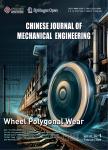Breakup of Cavitation Bubbles within the Diesel Droplet
Breakup of Cavitation Bubbles within the Diesel Droplet作者机构:College of Mechanical and Electrical Engineering Beijing Jiaotong University
出 版 物:《Chinese Journal of Mechanical Engineering》 (中国机械工程学报(英文版))
年 卷 期:2014年第27卷第1期
页 面:198-204页
核心收录:
学科分类:080704[工学-流体机械及工程] 080103[工学-流体力学] 08[工学] 0807[工学-动力工程及工程热物理] 0801[工学-力学(可授工学、理学学位)]
基 金:supported by National Natural Science Foundation of China(Grant No.51276011) Beijing Municipal Natural Science Foundation of China(Grant No.3132016) National Hi-tech Research and Development Program of China(863 Program,Grant No.2013AA065303) Opening Foundation of State Key Laboratory of Engines of China(Grant No.K2013-3)
主 题:supercavitation instability diesel droplet cavitation bubbles secondary breakup
摘 要:Supercavitation in the diesel nozzle increases the instability of droplets in part due to the two-phase mixture, while the effect of cavitation bubbles on the instability of drops is still unclear. In order to investigate the breakup of cavitation bubbles within the diesel droplet, a new mathematical model describing the disturbance growth rate of the diesel bubble instability is developed. The new mathematical model is applied to predict the effects of fluids viscosity on the stability of cavitation bubbles. The predicted values reveal that the comprehensive effect of fluids viscosity makes cavitation bubbles more stable. Compared with the viscosities of air and cavitation bubble, the diesel droplet's viscosity plays a dominant role on the stability of cavitation bubbles. Furthermore, based on the modified bubble breakup criterion, the effects of bubble growth speed, sound speed, droplet viscosity, droplet density, and bubble-droplet radius ratio on the breakup time and the breakup radius of cavitation bubbles are studied respectively. It is found that a bubble with large bubble-droplet radius ratio has the initial condition for breaking easily. For a given bubble-droplet radius ratio (0.2), as the bubble growth speed increases (from 2 m/s to 60 m/s), the bubble breakup time decreases(from 3.59 gs to 0.17 ps) rapidly. Both the greater diesel droplet viscosity and the greater diesel droplet density result in the increase of the breakup time. With increasing initial bubble-droplet radius ratio (from 0.2 to 0.8), the bubble breakup radius decreases (from 8.86 trn to 6.23 tm). There is a limited breakup radius for a bubble with a certain initial bubble-droplet radius ratio. The mathematical model and the modified bubble breakup criterion are helpful to improve the study on the breakup mechanism of the secondary diesel droplet under the condition of supercavitation.



